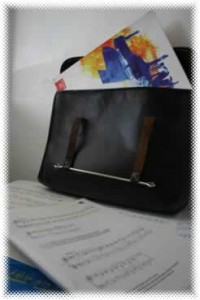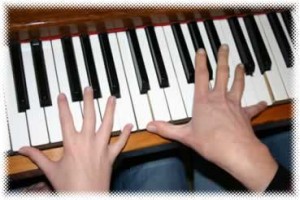Piano Examinations: Pieces
(See also Lesson Format: Current Piece and New and Old Pieces)
Once the scales are in progress, it’s time to start my pupil working on his first exam piece.
The examination board I use – the ABRSM – publishes a new set of pieces for piano exams every two years: the most-recently published set covers 2015-2016. The new ABRSM piano pieces at Musicroom.com are available (with or without CD) for grades 1-8 from the beginning of July 2014. You can also buy them from Amazon UK/Amazon US.
The publication of the new exam syllabus is a particularly exciting time for me and I can’t wait to receive the new pieces in the post. I generally ordered a book for each grade as – even if I don’t have a student currently at that standard – it’s likely that I will have some moving up to the next grade within the two-year period before the next syllabus is released.
Pupils are required to choose one piece from each of three sections – A, B and C. The A pieces (which tend to be from the Baroque period) are, in my experience, the least popular. The B pieces (Classical period or, occasionally, Romantic) generally spark a little more interest, while the C pieces (Romantic or sometimes modern jazz or blues) are likely to be the most appealing … and therefore more likely to be practised.
Three Choices
To enable my pupil to choose which exam piece to play from each of the three sections, I generally play the pieces through for him – just the ‘A’ pieces on the first occasion.
In most cases, I have purchased the CD, so could easily let my pupil listen to the pieces played ‘perfectly’ and professionally. However, by playing myself, I’m able to help the learner make his choice, as I have more awareness of where the difficulties lie – such as hand stretches which may be difficult for the younger pupil. (The ABRSM says pieces can sometimes be  adapted where the span of little hands can’t manage the original – however, there are some cases where this would have too profound an effect on the sound). Also, as I mentioned before, I do like to demonstrate that piano-playing – even by a teacher – is often far from perfect but can, nevertheless, sound musical.
adapted where the span of little hands can’t manage the original – however, there are some cases where this would have too profound an effect on the sound). Also, as I mentioned before, I do like to demonstrate that piano-playing – even by a teacher – is often far from perfect but can, nevertheless, sound musical.
As pupils often purchase the ABRSM exam books with the CD included (or download the tunes from the website), many have chosen their three pieces before being asked to. It is very rare for me to dissuade a pupil from his first choice as half the ‘battle’ with learning a new piece is actually enjoying the sound of the music and having a genuine desire to play it.
Marks Out of Ten
With my two sons, I let them listen to the CD and mark each piece out of 10 with a comment by the side. If their highest marked piece has particularly difficult challenges which I feel could ultimately bring their exam mark down, I may suggest looking at the second favourite piece as well … although I don’t like to put them off a challenge if they’re really keen. I always encourage them to choose a piece from the main exam book rather than the ‘alternative’ pieces which involve the extra (and often extremely high) cost of purchasing more music. However, if they are passionate about a particular alternative, I generally give in.
Teaching an exam piece is slightly different from teaching most other pieces as the aim for perfection has to be even greater. For this reason, I teach exam pieces in very tiny chunks, ensuring that fingering is correct (in some cases altering the prescribed finger patterns to suit the individual) and that staccatos and accents are observed at a very early stage.
In some cases, where there is a particularly difficult section in a piece of music, I start by teaching this, rather than working through it from the beginning. This way I can be reasonably confident that – by the time the exam comes around – the difficult part will have had more practice than the rest of the piece. If you always start teaching a piece which is relatively easy at the beginning but has a harder middle or end, you’ll find the pupil will practise the first part over and over again but lose interest later on.
Once the A piece has been mastered to a reasonable standard (although perhaps without all the dynamic markings followed, or the correct speed attained), we will move on to the B piece (while still ensuring that the A is played regularly) and finally onto the C piece.
Once all three have been learned, it’s a case of working on improving small sections or more general considerations such as tempo and flow. So, in some lessons only one or two out of the three pieces will be played.
Mistakes Start Later
Generally, the easiest part of teaching exam pieces is when the piece is brand new. The difficulties start later on, once the pupil has gone away and practised but perhaps using different fingering patterns than the ones you suggested, or missing sharps and flats, or maybe even inventing his own rhythm.
The main battle at the outset is to make your pupil understand the concept of ‘slowly’ (easier said than done! – but remember the alternative way of saying it: “play the first note then wait for a while before playing the second.”). Assuming he is able to do this (… although to be honest, most of my pupils are very reluctant to stop and think, preferring to make quick ‘guesses’) it should be relatively easy to teach him to play the correct NOTES. Obviously he should have acquired reasonable note-reading skills by this point – even if he’s still dependent on mnemonics.
When mistakes with notes are made several times, I generally circle the note in pencil on the score. Sometimes, I recommend that the pupil writes a few reminders at the top of the piece and reads these before he starts playing (for example: “Left hand octave lower on line 3” or “C♮s in bars 10-17”). It’s often useful to think carefully about the likely pitfalls before you actually start playing and to be absolutely determined that previous mistakes won’t be repeated.
I would generally discourage my pupil from writing note names on the score as I feel this is ‘cheating’ and will make him even more reluctant to try to identify the notes. Very occasionally I will allow it for the odd note with multiple ledger lines. I also generally write out the note names where there are complicated ORNAMENTS (quite common in A pieces) as these always take me a while to work out myself so it would be unfair to expect my pupil to play them correctly without help.
While turns and trills may be complicated to interpret, acciaccaturas (or ‘crushed’ notes) are generally easier for the learner to understand (although some – understandably – confuse these with appoggiaturas). The main difficulty with crushed notes is that some pupils tend to take too long over them which halts the flow of the music. To avoid this, I sometimes recommend playing the crushed note at the same time as the next note rather than just before it. Then, when the piece has been learned for a while, playing before the note can be resumed.
(continued on next page …)

 All my tips and advice on how to Teach Piano at Home are now available to read on your Kindle or other tablet device in my new 240-page eBook at Amazon - you can read more about it by clicking the red or blue button below.
All my tips and advice on how to Teach Piano at Home are now available to read on your Kindle or other tablet device in my new 240-page eBook at Amazon - you can read more about it by clicking the red or blue button below.